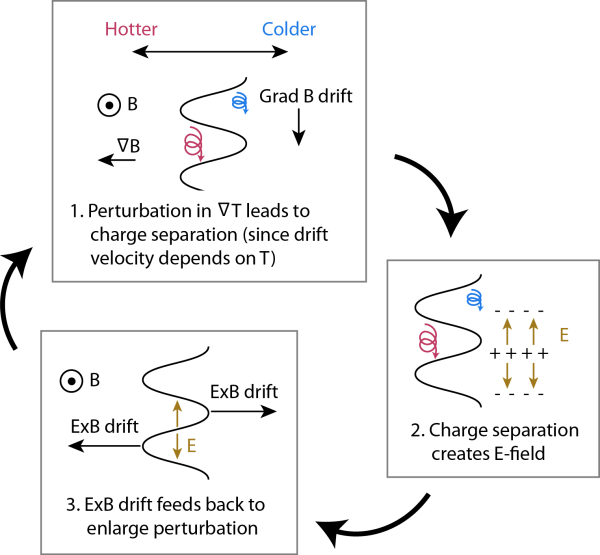Ion Temperature Gradient instability: Difference between revisions
(Added some wiki links) |
(Added a reference (more needed)) |
||
| Line 1: | Line 1: | ||
The ion temperature gradient (ITG) instability is a microinstability in [[tokamak]]s relevant to turbulence and the associated [[anomalous transport]]. | The ion temperature gradient (ITG) instability<ref> P. N. Guzdar, Liu Chen, W. M. Tang and P. H. Rutherford, ''Ion‐temperature‐gradient instability in toroidal plasmas'' [[doi:10.1063/1.864182|Phys. Fluids '''26''' (1983) 673]]</ref> is a microinstability in [[tokamak]]s relevant to turbulence and the associated [[anomalous transport]]. | ||
The instability occurs due to the nature of Grad-B drift. The Grad-B drift velocity of a particle (caused by a gradient in the magnetic field) is proportional to the particle's kinetic energy. Hotter particles drift further than colder particles. | The instability occurs due to the nature of Grad-B drift. The Grad-B drift velocity of a particle (caused by a gradient in the magnetic field) is proportional to the particle's kinetic energy. Hotter particles drift further than colder particles. | ||
| Line 14: | Line 14: | ||
* [[Plasma instability]] | * [[Plasma instability]] | ||
== References == | |||
<references/> | |||
Revision as of 15:33, 19 October 2016
The ion temperature gradient (ITG) instability[1] is a microinstability in tokamaks relevant to turbulence and the associated anomalous transport.
The instability occurs due to the nature of Grad-B drift. The Grad-B drift velocity of a particle (caused by a gradient in the magnetic field) is proportional to the particle's kinetic energy. Hotter particles drift further than colder particles.
Hence, if a temperature gradient is aligned with a magnetic field gradient (as occurs in a tokamak), particles in the hotter region will drift further. If there is a perturbation in the temperature gradient, then the difference in drift velocities will create charge separation. The charge separation creates a electric field. This electric field creates an drift which increases the perturbation's amplitude. The positive-feedback nature of this loop leads to exponential growth of the instability.
Note that if the temperature gradient is anti-parallel to the magnetic field gradient, the drift will suppress the perturbation rather than increase it. This situation occurs on the inner, "good-curvature" side of the tokamak.
See the figure for a graphical explanation.
See also
References
- ↑ P. N. Guzdar, Liu Chen, W. M. Tang and P. H. Rutherford, Ion‐temperature‐gradient instability in toroidal plasmas Phys. Fluids 26 (1983) 673

